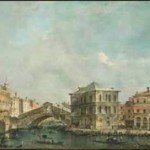Venice: Exhibitionist City, Then and Now
“It is always assumed that Venice is the ideal place for a honeymoon. This is a grave error. To live in Venice or even to visit means that you fall in love with the city itself …After your first visit you are destined to return at every possible chance or with every possible excuse. There is no staying away for long. You are inevitably drawn back as though by magic.”
– Peggy Guggenheim, Out of this Century: Confessions of an Art Addict
In 1948, Peggy Guggenheim exhibited her collection of avant garde paintings and sculptures at the Venice Biennale. Among the 73 artists featured were Picasso, Ernst, Kandinsky, Pollock and Rothko. The show was revolutionary in its presentation of Cubist, Surrealist and Abstract works to the general European public, as well as to contemporary Italian artists. Soon after the show, Peggy settled in Palazzo Venier dei Leoni, where from 1951 onward her collection opened its doors to visitors. The heiress’ choice of Venice as a home and showcase for her works is significant, for she had already experienced the contemporary art scene in Paris, London and New York. Located in a Renaissance palazzo on the Grand Canal, the Peggy Guggenheim collection in fact highlights Venice’s dual identity as a historic maritime city and a protagonist in artistic innovation.
Venice, also named La Serenissima (the most serene), dominated the Mediterranean as a center of commercial and cultural trade from the Middle Ages into the 17th century. The city’s established contact with the east is evidenced by numerous Byzantine style structures, including the Cathedral of San Marco. Construction of the Cathedral was spurred by the arrival of St. Mark’s relics, which were brought from Alexandria to Rialto in 829 and established the Evangelist as the patron saint of Venice. Local artists were subsequently inspired to paint complex narrative cycles from Mark’s life and to decorate the city with leonine imagery honoring his symbol of the winged lion.
It was Venice herself, however, who would prove to be the greatest muse for her native artists. The unique lighting effects found in the floating city inspired Renaissance painters to search for novel pictorial traditions. Giovanni Bellini, for example, was among the earliest adaptors of the oil medium, a technique that eventually replaced tempera as it allowed artists to layer different colors and to paint more spontaneously. Realizing the potential of oil painting, Giorgione tested its effects on canvas, embracing gestural brushstrokes as part of his signature style. Titian, Tintoretto and Veronese all continued this legacy, emerging as leaders of an innovative manner that challenged the Florentine tradition of disegno — with its emphasis on preparatory drawings and crisp contour — and instead focused on color and light as defining characteristics of a composition. In the 18th century, Venetian interest in lighting effects culminated with the shimmering frescoes of Tiepolo, as well as the luminous vedute of Venice by Guardi and Canaletto.
Multi-faceted as it was, the Venetian tradition was consistent in its celebration of radiant light and saturated color, ultimately laying the groundwork for future generations of painters who would visit Venice and find themselves forever changed in the face of her incandescent vistas. In 1819, for example, Turner was captivated by the lighting effects found in the city’s lagoon and radically altered his style of painting to consider the dematerializing effects of light on form. His advancements served as an example for later
Impressionist artists, including Monet, who engaged Venice’s elusive light in his paintings of Santa Maria della Salute and the Doge’s Palace. Whistler’s artistic vision was also permanently altered by his visit to Venice. Moved by his personal discovery of the city in 1879, the American born painter created a series of innovative etchings (which he later donated to the city) as well as nearly one hundred pastels depicting Venice’s quiet calli (streets) and winding canals. What Whistler captured on paper, John Ruskin immortalized in writing in The Stones of Venice (1851-53), an ode to the magical city’s Gothic and Byzantine structures surrounded by water and worn with age.
Despite Venice’s lasting attraction for visitors, the city had experienced a gradual cultural and economic downturn since surrendering to Napoleon in the late 18th century. Recognizing her own decline, Venice organized a national exhibition of painting and sculpture in 1887 that was housed in provisional buildings in the Giardini. The exposition established the foundation for the first Biennale that was inaugurated on April, 30th, 1895. The occasion drew over 200,000 visitors and artists and marked Venice’s renewed identity as a cutting edge center for the visual arts. As the critic Ugo Ojetti wrote: “until now, who ever in Italy spoke or wrote about any type of artistic venture, was tolling a death bell…All those with hope, met elsewhere in Paris or Munich, Barcelona or Vienna, in London or Zurich…[but] today they are relying on Venice.”
A series of public and private purchases related to the Biennale exhibitions also led to the establishment of the Cà Pesaro Galleria Internazionale d’Arte Moderna in 1902. This forward-looking gallery was host to Boccioni’s first one man show in 1910 – the same year that witnessed Marinetti’s scattering of Futurist leaflets from the clock tower of Piazza San Marco. With its Gothic pinnacles and narrow canals, Venice provided the ideal backdrop for the Futurists’ engagement with and rupture from artistic tradition.
Nearly a century later, artists featured in the Biennale would further explore this paradoxical role of Venice as an emblem of tradition and a locus for innovation. In his 2001 Waterfire, Fabrizio Plessi, a graduate of Venice’s own Accademia delle Belle Arti, created an ode to the importance of water for the aquatic city. With 15 screens placed in the Museo Correr’s windows facing Piazza San Marco, Plessi’s video installation depicted water metamorphosing into fire, and fire into water. In 2010, the Danish artist Olafur Eliasson’s Your Split Second House featured three water sprays in a dark room briefly illuminated by strobe lighting. Striking on their own accord, the flickering flames of Plessi and the kinetic water twists of Eliasson proved spectacular against the larger context of Venice’s historic palazzi and expansive lagoon. Embracing water and light as vital components of their inventions, these contemporary artists’ exhibitions inevitably engaged with the works of Venetian artists of centuries past.
As part of this year’s 54th Biennale, Paolo Ventura’s works will be featured in the Italian national pavilion. Filled with nostalgia, Ventura’s staged photographs recreate bygone eras of Italian history, and have included snapshots from Venice’s ghetto in the 1940s. Ventura’s work seems a fitting choice for the 150th anniversary of Italy’s festa dell’unità, and should prove especially compelling in the context of the Serenissima – a city that will continue to remind visitors of its artistic heritage while ushering in modern modes of representation and abstraction.
About the Author
Veronica Maria White is currently a Core Lecturer at Columbia University as well as a Lecturer at the Metropolitan Museum of Art. She received her B.A. from Princeton University and her Ph.D from Columbia University, where her dissertation, “Serio Ludere: Baroque Invenzione and the Development of the Capriccio,” focused on the visual and critical components of 17th-century Italian drawings and prints known as capricci. Her academic awards include the Jane and Morgan Whitney Fellowship at the Metropolitan Museum of Art, the Columbia University Starr Fellowship, the Swann Foundation Fellowship from the Library of Congress, and the Princeton Pettoranello Foundation Research Grant. She has also taught at Rutgers University and Vassar College, and has worked at the Peggy Guggenheim Collection in Venice, where she assisted with the exhibition of “The Timeless Eye: Master Drawings from the Jan and Marie-Anne Krugier-Poniatowski Collection” in 1999. She has contributed to several exhibition catalogues, including Playing with Fire: Neoclassical Terracotta Models (New York: Metropolitan Museum of Art, 2003), and Peter Paul Rubens: The Drawings (New York: Metropolitan Museum of Art, 2004). Her lectures and publications have included papers on Gianlorenzo Bernini, Guercino, Rubens and Stefano della Bella. She is currently working on a book on the capriccio, as well as an article focusing on Guercino’s role as a collector of drawings and prints.







